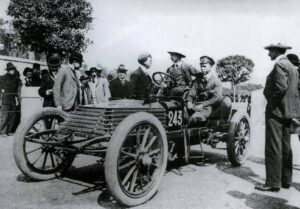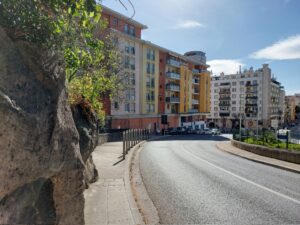One of the many peculiarities of 2020 is the upending of the international sporting calendar. While we are worried & discombobulated, dealing with ‘the new normal’, fettling our Zoom background – wondering how we will pay the rent – the ‘powers that be’ have been scrambling to stage their marquee events.
So, we find the 24 Hours of Le Mans being held on the third weekend in September, which happens to be the anniversary of another great World Championship sports-car race. The oldest race still contested in our sport, the RAC Tourist Trophy. Specifically the race at Dundrod, Northern Ireland, on Saturday 17th September 1955. A year of tragedy, uncertainty and a shifting calendar – but for entirely different reasons to 2020.
The World Sports Car Championship of this period was contested amongst manufacturers, and Daimler-Benz had it firmly in their sights. Not only did it constitute another world title, but the events themselves were iconic. Desirable additions to any team’s palmarès, if not essential for Daimler-Benz. So to that end, having focused entirely on Grands Prix in 1954, Mercedes created a second Silver Arrow for their quiver.
The 300 SLR’s origin was obvious in its type number – W 196 S. This was the hugely successful W 196 Grand Prix car’s chassis & running gear expanded into an open 2-seater, 3-litre, 310bhp road rocket. Work overseen, as ever, by Rudolf Uhlenhaut. Proclaimed as “the greatest sports racing car ever built – really an unbelievable machine” by Stirling Moss, the 300 SLR finished 1st & 2nd on its racing debut at the Mille Miglia in June. Moss and navigator Denis Jenkinson achieving a remarkable, record-breaking victory in the thousand-mile Italian road race.
That mighty debut, in what was the third round of the championship, opened Mercedes’ account with 8 championship points. Ferrari lead on 18 points, having won the opening round in Buenos Aires. Maserati, second in the standings, had scored their 11 points consistently. Mercedes and Jaguar were tied on 8 – Hawthorn having won at Sebring.
A great battle was anticipated for the next round – Le Mans on the 12th of June.
The appalling tragedy at Le Mans that year changed everything. When thoughts turned again to the sports-car championship at the end of the summer, the Carrera Panamericana and the Nürburgring 1000km had already been cancelled. As had the German, Swiss and Spanish Grands Prix. Furthermore, Daimler-Benz was considering withdrawing from motor sport at the end of the season. When Mercedes went testing at the newly-rebuilt Monza in August, they must have known that the rest of the season would be win or bust.
Fangio’s victory in the Italian Grand Prix on 11th September – at the head of a 4-car Daimler-Benz entry – secured his third World Drivers Championship. One World Championship down, one to go. The sportscar championship now only had two rounds remaining with Mercedes-Benz in 4th place behind Ferrari, Jaguar & Maserati.
The Mercedes squad packed up and left Monza… four days to get to Belfast with their phalanx of 300 SLRs.
After preparation and scrutineering in Belfast, the teams started ‘training’; not that Dundrod held many secrets for the top competitors. The 7.4 mile loop of secondary roads had been in use for international sports-car and Formula One racing since 1950. Narrow, ditch & tree-lined, numerous
blind dips & bends… bloody fast! “Dundrod circuit is surely one of the finest road-racing courses in Europe…”, noted Denis Jenkinson. It probably was, but the world had changed at La Sarthe that June and this was to be Dundrod’s swansong for 4-wheel motor sport.
Leaving nothing to chance, Mercedes had brought no fewer than five 300 SLRs. Two were assigned for practice – ‘2T’ 0002/55 in it’s first championship appearance, although running a Le Mans-style ‘air-brake – and ‘1T’ 0007/55, the new coupé version which had been destined for the now-cancelled Carrera Panamericana. Driver pairings, like everything, were planned to the Nth degree by Mercedes team manager Alfred Neubauer.
Mercedes number 11 was the junior car, chassis 0003/55 which had finished 2nd on the Mille Miglia in Fangio’s hands. At Dundrod it was to be driven by new boy Wolfgang von Trips – who had driven 0007/55 all the way from Stuttgart to ‘get his eye in’ – and André Simon, driver of the
third W 196 Grand Prix car at Monaco in May.
Number 9 was the ‘auld hands’, as the locals might have called them. A fast & solid combination, Juan Manuel Fangio and Karl Kling were assigned 0005/55. The car Kling had crashed at the Mille Miglia.
Mercedes’ best hope for outright victory though was the 10 car, shared by Dundrod specialist Moss and the American John Fitch, who had partnered Pierre ‘Levegh’ at Le Mans. Car number 10 was chassis 0004/55, which had won the Mille Miglia with race number 722.
If Mercedes-Benz were to get back in the hunt for the World Championship, Moss & ‘722’ would have to push themselves to the limit once more. Nothing less would do, nothing less was expected.
Following two days of practice, in typical mixed Ulster weather, the entry of 55 cars was whittled down to 49 starters. 49 cars that lined up for the start in cylinder capacity order – from Mercedes-Benz to 750cc Panhard.
A single Jaguar D-type for Mike Hawthorn and local boy Desmond Titterington. The three Mercedes-Benz 300 SLRs for Moss/Fitch, Fangio/Kling & von Trips/Simon. Three Ferrari Monzas became two after Olivier Gendebien crashed in practice, breaking his arm. The remaining 3-litre cars lined up with Castellotti/Taruffi & Trintignant/Magioli. Maserati had two 3-litre cars for Behra, Musso, Bordoni & Muy. The 3-car Aston Martin entry was lead by Peter Collins & Tony Brooks. Porsche, MG, Lotus, DB, Connaught, Cooper, Kieft, DKW… made up the field, in search of class or ‘index of performance’ success.
And so they lined up for the ‘Le Mans’ start in front of the grandstands… wait… wait… flag drops!.. with a leap Moss is in his 300 SLR and the straight-eight engine roars to life. The field scrabbles away from the pits as Stirling blasts past Hawthorn’s Jaguar to lead onto ‘the flying kilometre’, and into the countryside. The race is on – 84 laps, 625 miles – and Moss and Hawthorn are attacking it like a Grand Prix.
Lap 1: Moss – Hawthorn – Fangio – von Trips – Behra – blast past the pits. Moss through the speed trap at 146 mph… Hawthorn at 147. The pace is brutal. Have Neubauer’s plans survived first contact with the enemy?
Onto the second lap, and from the start line spectators & teams can see a column of smoke rise in the distance. The worst has happened almost immediately. Over the blind rush down ‘Deers Leap’ seven cars have been caught up in a terrible accident. Jim Mayers and Bill Smith are dead… and the field races on.
Hawthorn is flat-out, throwing everything he’s got at the pursuit, even though the Jaguar is more suited to blasting down Les Hunaudières than Irish B-roads. As Stirling gradually extends his lead they cross the line: Moss – Fangio – Hawthorn – von Trips. The junior Mercedes driver
already justifying his inclusion. Hawthorn and Fangio continue to scrap over second place.
After ten laps Moss has a 47 second lead over Mike’s Jaguar, with Fangio only 2 seconds further back. Lap 13 – Fangio passes the pits in front of the Jaguar once again. Mercedes-Benz 1st & 2nd, but not a moment to breathe.
4 minutes, 42 seconds.
94.67mph, average speed.
Lap 19, and Hawthorn has smashed the all-time lap record… set by Farina on an Alfa-Romeo 158 Grand Prix car. Yet, he’s making little impression on Moss. Neubauer realises he can do nothing but let Stirling run. In reserve he has Fangio – now tucked behind Hawthorn – and young von
Trips, holding off the challenge from Peter Collins in the works Aston Martin DB3S.
25 blistering laps have passed, and the leaders are preparing for the first round of pitstops. Jaguar is first to blink – the crowd cheers as Dessie Titterington takes over from Hawthorn, and the D-type roars away from the pit apron in 3rd place. Next, Fangio – fuel & rear tyres for the
Mercedes, as Kling takes over driving duties. But it’s slow – 1 minute, 50 seconds – and the crowd rises again as Titterington’s Jaguar rushes past to reclaim second place.
The leader must stop soon… but drama!
The right-rear Continental tyre on 0004 has blown at 130mph. Stirling’s reflexes keep it out of the ditch, but now he’s completing the lap with the tread and most of the rear wheel arch gone. The 300 SLR slides to a halt in the pit.
Tyres changed. Ragged bodywork ripped off. Fitch jumps into the driver’s seat and… the crowd are on their feet.. it’s Titterington! Jaguar leads! Neubauer’s stopwatch hits 2 minutes, Fitch sets off in pursuit.
As the second stint settles down is apparent that while Titterington isn’t as fast as Hawthorn, Fitch is slower than Moss. Jaguar are opening up a lead. Then Collins in the Aston Martin gets past von Trips… and Kling. Mercedes suddenly look in disarray.
Lap 31, and Titterington leads by 54 seconds now from Fitch in 2nd and Collins in 3rd. The Aston pits are ready for their stop – to replace Collins with Tony Brooks – but the DB3S has suddenly developed a misfire, and their chances of ‘a result’ are dashed.
Rain!
Rain around the back of the circuit, and the gap at the front of the race opens even more. Two minutes now between the Jaguar and the Mercedes. The race is slipping away… championship hopes fading… Jaguar are protesting to the stewards about Stirling’s damaged car running with no rear wheel arch… pressure… Neubauer makes the call.
0004 is back in the pits after only 7 laps. Fitch out, Moss in. The rain has stopped falling, but the track is sodden as Stirling rejoins in 3rd place… and he is relentless. Past Kling, in the sister Mercedes-Benz, and off in pursuit of the leading Jaguar… as the sky breaks again… torrential rain.
Jaguar has to react while they have track position. Lap 50, they pit. Fuel, oil, 1 rear tyre for the D-type. Hawthorn jumps in and resumes the fight… just in front of Moss. But Stirling Moss and 0004/55 are undeniable. Mike can do little to fight off the Moss & Mercedes challenge in the wet,
and Stirling passes him for the lead on lap 56.
It’s as good as over – and, as if the gods know it, the sun comes out to warm the circuit over the last 20 laps. Positions set, everyone running to the flag, when with 2 laps to go the circuit PA announced that Hawthorn had stopped. Mike walking back to the pits to huge applause, to tell of how the D-type had cried enough and dumped all its oil.
And so, Stirling Moss & W 196 S 0004/55 had won once again at record speed. Leading home a Mercedes-Benz 1-2-3. Maximum points won, their rivals denied.
For Stirling – the Tourist Trophy, a garland… and cake from his mother. September 17th was his 26th birthday.
For Neubauer and Mercedes-Benz – the championship deficit slashed to only 2 points, and lots to learn. The title would be decided at the Targa Florio. Moss and 0004 would lead the charge, but Neubauer knew the driver line-up needed bolstering… and after this race he knew just who he wanted.
So, what happened in Sicily? How did the championship finish?
That will have to wait for another time, friends. Because the Targa Florio is never just a footnote.
In memory of Richard Mainwaring, Jim Mayers and William Smith. Lost, chasing time, at Dundrod 17th September 1955.


